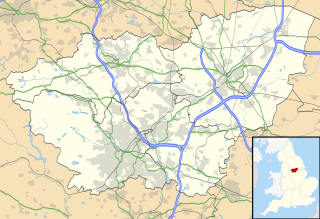
Dronfield is a town in the North East Derbyshire district of the county of Derbyshire in the East Midlands region of England. It comprises the three communities of Dronfield, Dronfield Woodhouse and Coal Aston. It is sited in the valley of the small River Drone, and lies between the town of Chesterfield and the city of Sheffield. The Peak District National Park lies three miles (4.8 km) to the west. The town's name means open land infested with drones.

Beighton —which includes the districts of Beighton, Hackenthorpe, Owlthorpe, and Sothall—is one of the 28 electoral wards in City of Sheffield, England. It is located in the eastern part of the city, on the border with Rotherham and covers an area of 5.7 km2. The population of this ward in 2011 was 17,939 people in 7,538 households.

Birley Spa is a community bath hall and a Victorian bathhouse in the Hackenthorpe district of the City of Sheffield, England. It was built for Charles Herbert Pierrepont, 2nd Earl Manvers and the Lord of the Manor of Beighton in 1842, and initially was a hotel with spa baths beneath. Subsequently, it was used for many years as private dwellings. In the 1973 it was given Grade II listed building status.

Sir Godfrey Newbold Hounsfield, CBE, FRS, was an English electrical engineer who shared the 1979 Nobel Prize for Physiology or Medicine with Allan McLeod Cormack for his part in developing the diagnostic technique of X-ray computed tomography (CT).

The areas of Sheffield, a city and metropolitan borough in the north of England, vary widely in size and history. Some of the areas developed from villages or hamlets, that were absorbed into Sheffield as the city grew, and thus their centres are well defined, but the boundaries of many areas are ambiguous. The areas of Sheffield do not play a significant administrative role, but the city is divided into 28 electoral wards for local elections and 6 parliamentary constituencies for national elections.

The Roman Catholic Diocese of Hallam is a diocese of the Latin Church of the Roman Catholic church in England.
This timeline of Sheffield history summarises key events in the history of Sheffield, a city in England. The origins of the city can be traced back to the founding of a settlement in a clearing beside the River Sheaf in the second half of the 1st millennium AD. The area had seen human occupation since at least the last ice age, but significant growth in the settlements that are now incorporated into the city did not occur until the industrial revolution.
The Kniveton Baronetcy, of Mercaston in the County of Derby, was a title in the Baronetage of England. It was created by King James I on 29 June 1611 for William Kniveton of Mercaston Hall, Muggington, Derbyshire. The family originated in the village of Kniveton,, from where their name derived. Branches of the family later had seats at Bradley and by virtue of the 15th century marriage of Nicholas Kniveton, at Mercaston, near Muggington, Derby

The Church of St Mary the Virgin is situated in Beighton, a suburb of the City of Sheffield, England. It is located just off High Street, it is the parish church for the parish of Beighton and a Grade II* listed building. Although the original church dated from the 12th century there is no remaining trace of this original structure, although there are some later Medieval parts. It is dedicated to Mary, the mother of Jesus. The present minister is Mike Healey.
The following is a timeline of the history of the city of Derby, England.

Thomas Gladwin (fl.1668) of Tupton Hall, in the parish of Wingerworth near Chesterfield, Derbyshire, was Sheriff of Derbyshire in 1668.

St Peter and St Paul’s Church, Eckington is a Grade I listed parish church in the Church of England in Eckington, Derbyshire.

Normanton Spring is a suburb and former hamlet located 4 miles east of Sheffield's City Centre, now classed as a historic township of the city. Due to expansion during the 1960s, the hamlet became a part of Sheffield City.

Drake House was a 17th-century residence located in Beighton, Sheffield, England. References to the building go back to the 14th century.

Nether Wheel, also known as the Lower Sickle Wheel and earlier the Birley Moor Wheel, is a ruined sickle grinding wheel that stood on the Shire Brook as it flowed through Normanton Spring, Sheffield. The wheel dates back to the early 18th Century.

















